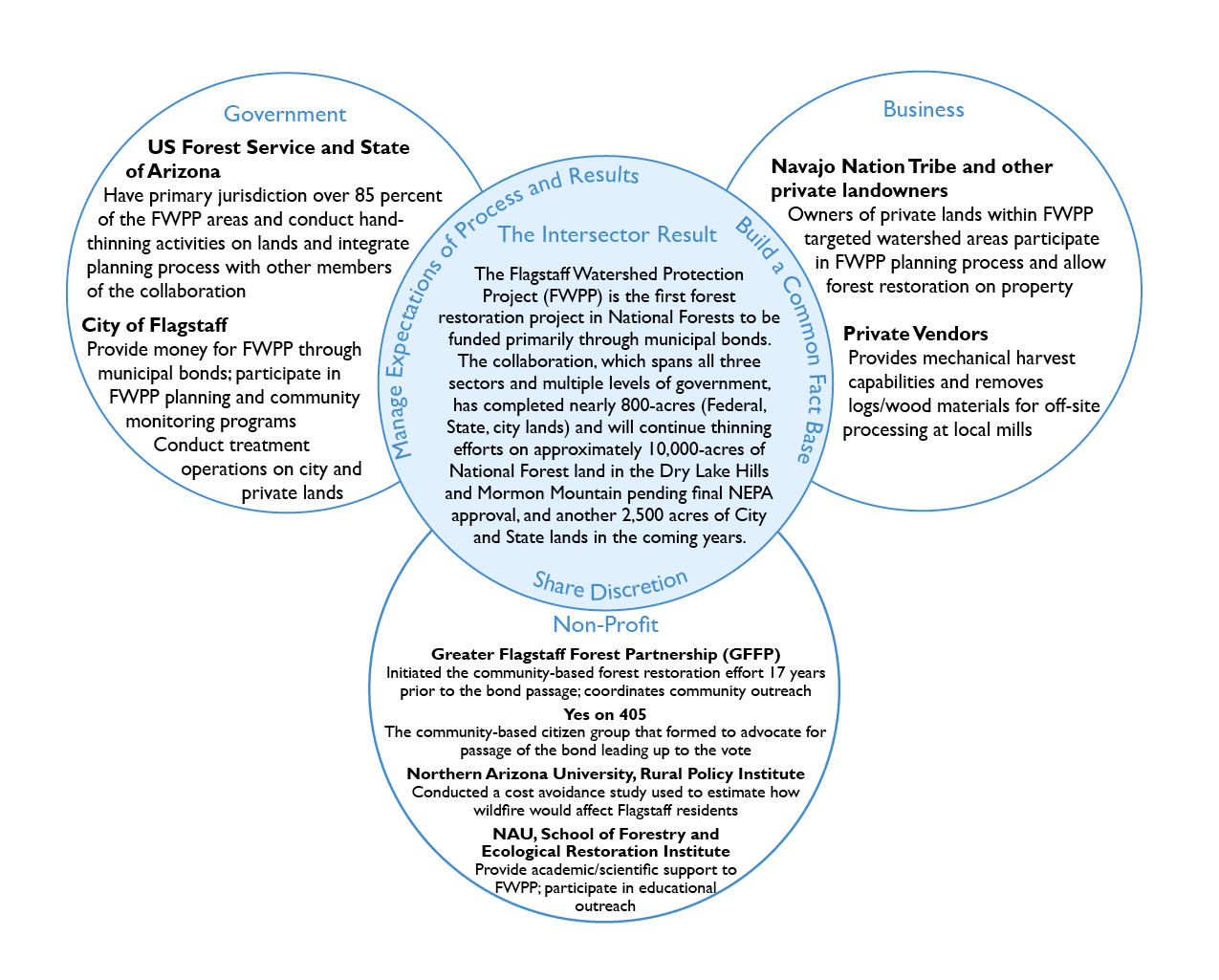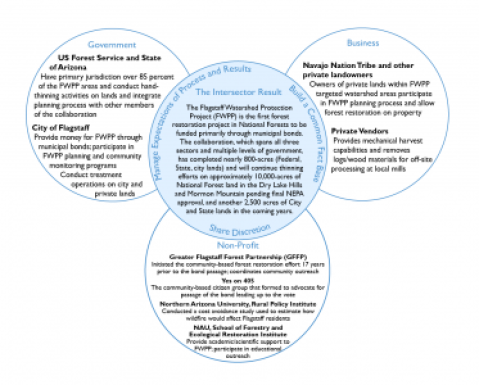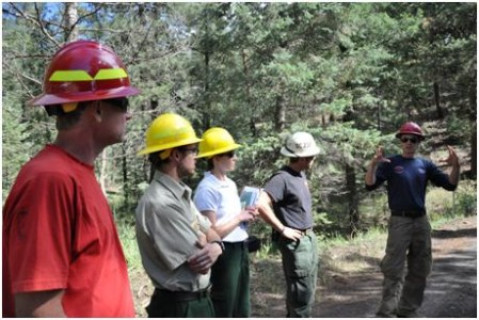Widgetized Section
Go to Admin » Appearance » Widgets » and move Gabfire Widget: Social into that MastheadOverlay zone
Reducing the Risks of Catastrophic Wildfires through Collaboration
The views expressed are those of the author and do not necessarily reflect the views of ASPA as an organization.
By The Intersector Project
January 26, 2016
Years of extensive wildland fire suppression in the Southwest left many forests with unnaturally high levels of materials that fuel forest fires, like dense undergrowth and thick litterfall. This has changed the natural fire ecology from low, fast-burning wildfires to much larger crown fires that kill trees and undermine landscape integrity.
In 2010, a wildfire and subsequent flooding on the east side of the San Francisco Peaks, just north of Flagstaff, Ariz., caused more than $150 million in combined suppression and recovery. A similar wildfire in either of the two Flagstaff watersheds could potentially flood much of downtown and/or disrupt 50 percent of the city’s water supply, resulting in significant long-term financial and lifestyle impacts within the community.
Recognizing the need for preventative action, a partnership between the city, county, state and federal governments, with support from local nonprofit and for-profit organizations, has resulted in the Flagstaff Watershed Protection Project (FWPP). With Officer Paul Summerfelt coordinating its activities, FWPP mitigates the risk of potentially devastating wildfires in Flagstaff’s critical watershed areas by managing forest fuels and restoring natural ecosystem functions. This includes thinning out dense forests and reintroducing a low-intensity fire regime. To fund FWPP, Flagstaff passed a $10 million municipal bond with 74 percent approval rate, making FWPP the only forest restoration work on National Forests funded through municipal bonds.
Tactics for Collaboration Success

Share a Vision of Success. A shared community vision of a safer Flagstaff developed long before residents voted to fund FWPP. In 1996, the Flagstaff Fire Department, Northern Arizona University (NAU), Grand Canyon Trust and the U.S. Forest Service (USFS) formed the Greater Flagstaff Forest Partnership (GFFP) to assess and reduce the growing risk of catastrophic wildfires within the region. Together, they unanimously developed one of the nation’s first landscape-based approaches to restoration forestry. Rather than focus solely on ecological concerns, GFFP expanded their scope to include economic and social considerations.
In order to bring public support into alignment with the mission of the collaboration, GFFP addressed human-posed barriers to action, led extensive public outreach, conducted economic viability analyses and encouraged public involvement on management issues. After experiencing the type of wildfire risk reduction envisioned by FWPP through GFFP, Flagstaff residents accepted the need for immediate action and understood the ecological, economic and social benefits of restoring Flagstaff’s fire-sensitive watershed.
Share Discretion. FWPP is the first watershed protection project funded primarily by municipal bonds for work on federal lands outside of city limits. This unique funding structure poses a unique challenge to the allocation of decision-making authority. For any land management activity occurring on National Forests, USFS has the jurisdictional legal responsibility to act as the sole decision-maker; a responsibility they cannot share with any other entity. Likewise, similar jurisdictional issues also surround state, tribal and private lands within the scope of FWPP.

Conversely, the city of Flagstaff, as providers of the municipal bond, can refuse to pay for any management decision they feel extends beyond the best interests of Flagstaff residents. To prevent conflict at the decision-making level, FWPP’s diverse group of multilevel “decision-makers” meet monthly to discuss planning, development and implementation of FWPP. Allowing each sector to express their desired outcome for the project prevents surprises during implementation, promotes continuity of action and ensures that all stakeholders reach consensus before any official decision is made. In the two years since Flagstaff residents approved the $10 million bond, no conflicts have arose from this unique integrated approach to parallel decision-making.
Establish Transparency of Viewpoints. The ability of FWPP managers to acknowledge conflicting viewpoints has greatly contributed to the project’s community support and cross-sector buy-in. For example, forest managers recognize habitat loss due to catastrophic wildfire as the greatest threat to endangered species viability in the Southwest. Some environmental groups, however, have raised concerns over tree thinning activities and its effect on habitat availability for Mexican spotted owls, an endangered species. Rather than ignore these groups, FWPP managers created meetings to hear and respond to these concerns.
This transparency even extends to the USFS’s Environmental Impact Statement, which does not list a preferred alternative for FWPP-related federal action. As a result, the public remains engaged and this creates an open atmosphere for comment on how USFS should proceed. This open flow of information creates a better interdisciplinary understanding of forest restoration, fosters mutual respect among stakeholders and encourages comprehensive restoration policies.
FWPP is expected to take between eight and 10 years to complete. Currently approaching the project’s fourth year since the municipal bond measure passed, the collaboration has already established a number of intergovernmental agreements and memorandums of understanding between FWPP participants, including the City of Flagstaff, USFS, the State of Arizona, GFFP and NAU. These agreements address the working arrangements of the collaboration and establish a financial management plan for FWPP. Read our full case study on FWPP or visit its website to learn more.
Author: The Intersector Project is a 501(c)(3) nonprofit organization dedicated to advancing cross-sector collaboration as a way to address society’s pressing issues. We work to provide practitioners in every sector with the tools they need to implement collaborative solutions to complex problems.






Follow Us!